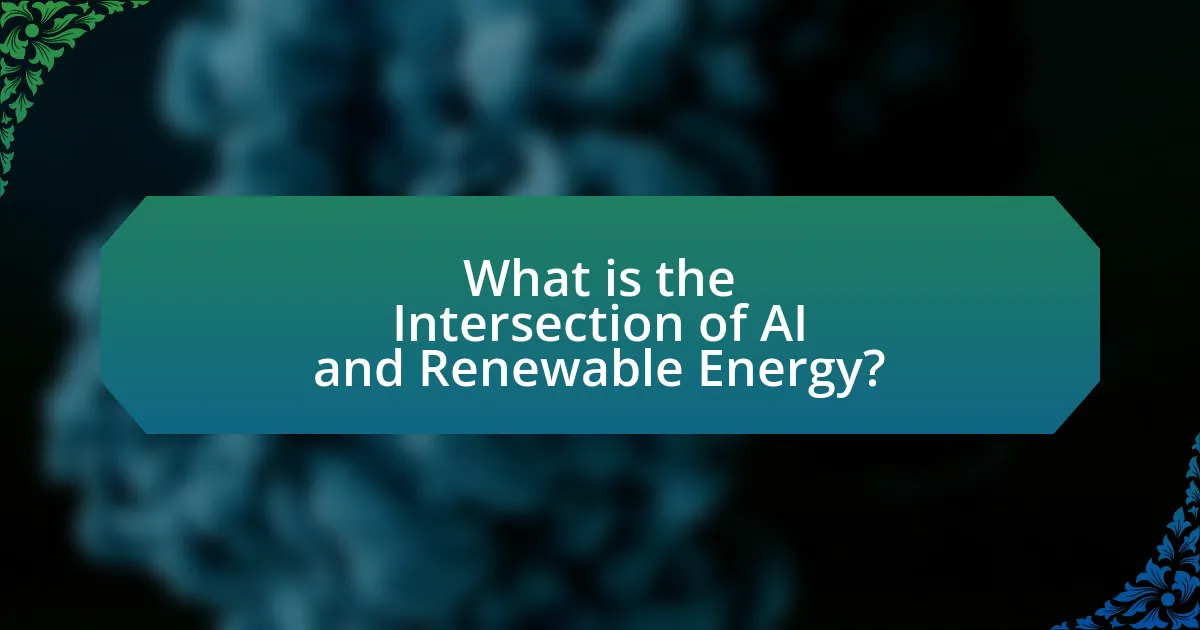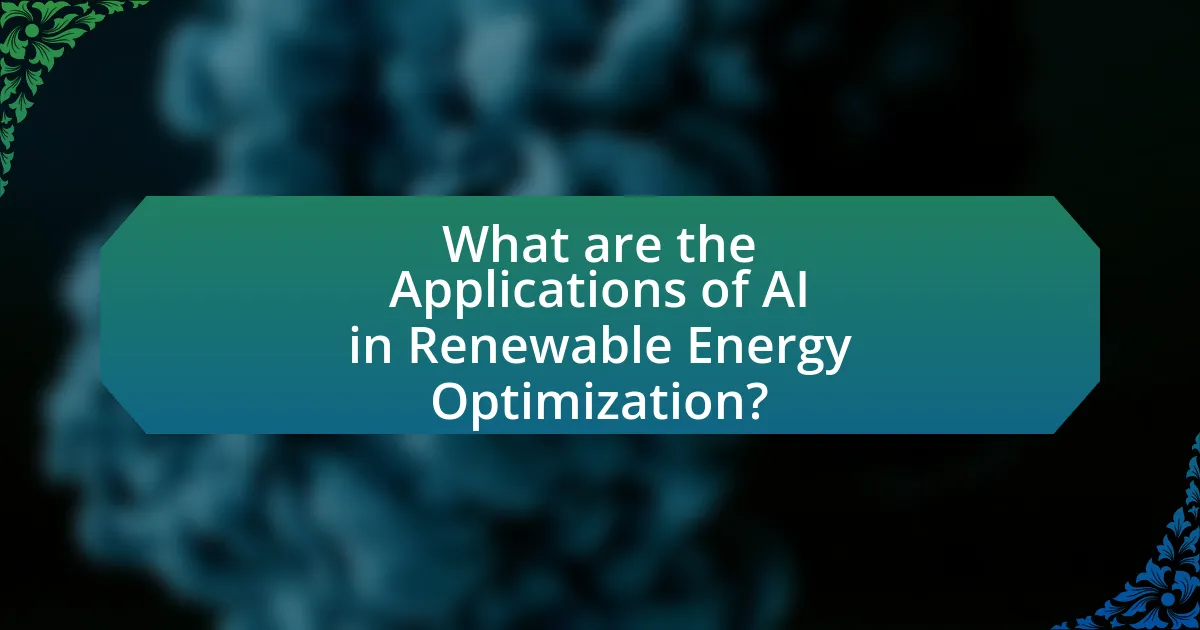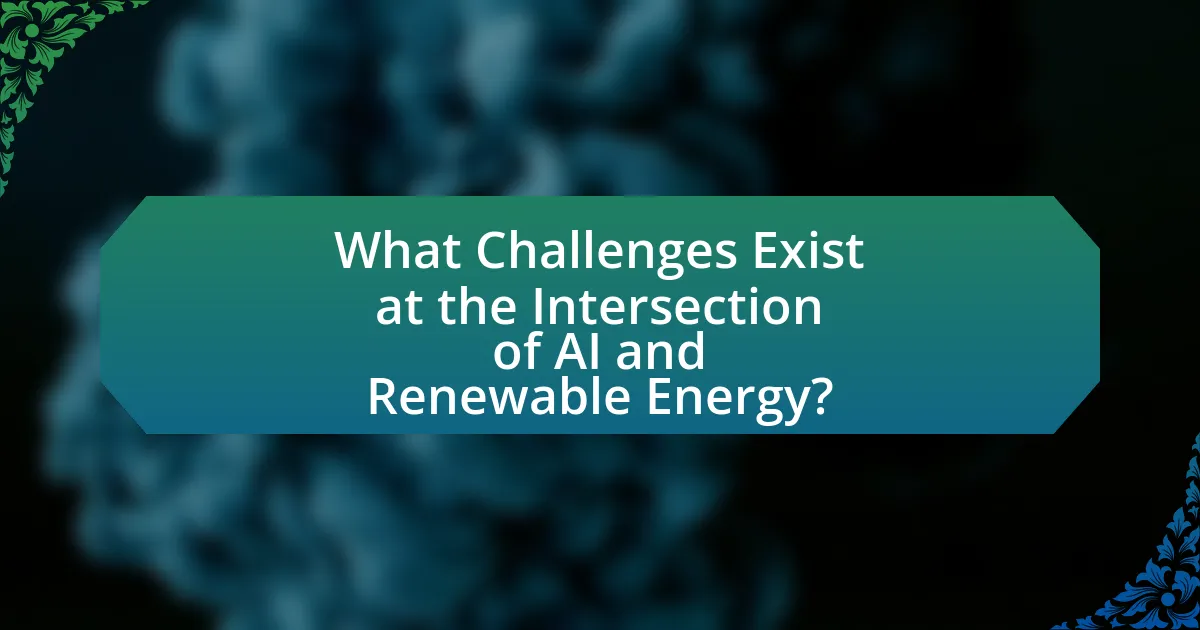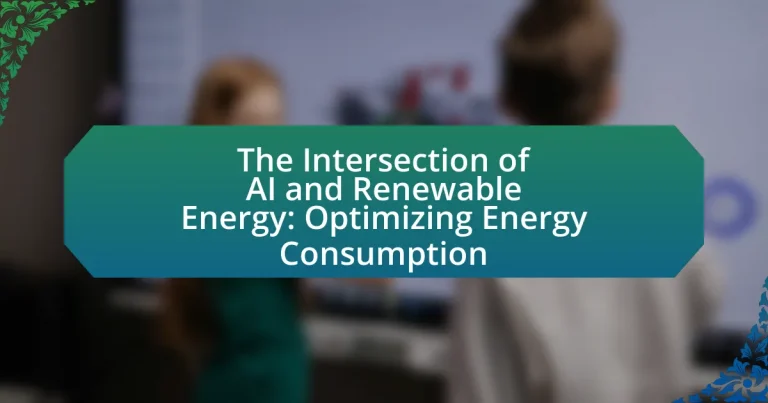The article focuses on the intersection of artificial intelligence (AI) and renewable energy, emphasizing how AI technologies enhance the efficiency and integration of renewable energy sources. It discusses the application of AI algorithms in optimizing energy production and consumption, improving grid management, and forecasting energy demand. Key AI technologies such as machine learning and predictive analytics are highlighted for their roles in enhancing operational efficiency and reducing costs. The article also addresses the environmental impacts of energy consumption, the importance of optimizing energy use for sustainability, and the challenges and best practices associated with implementing AI in renewable energy systems.

What is the Intersection of AI and Renewable Energy?
The intersection of AI and renewable energy involves the application of artificial intelligence technologies to enhance the efficiency, reliability, and integration of renewable energy sources. AI algorithms analyze vast amounts of data from renewable energy systems, such as solar panels and wind turbines, to optimize energy production and consumption. For instance, AI can predict energy demand patterns, enabling better grid management and reducing waste. According to a report by the International Renewable Energy Agency (IRENA), AI can improve the operational efficiency of renewable energy systems by up to 20%, demonstrating its significant impact on optimizing energy consumption.
How do AI and renewable energy technologies integrate?
AI and renewable energy technologies integrate through advanced data analytics, predictive modeling, and automation to enhance energy efficiency and management. AI algorithms analyze vast amounts of data from renewable energy sources, such as solar and wind, to optimize energy production and consumption patterns. For instance, AI can forecast energy demand and supply fluctuations, enabling grid operators to balance loads effectively. Research by the International Renewable Energy Agency (IRENA) indicates that AI can improve the efficiency of renewable energy systems by up to 30%, demonstrating its significant impact on optimizing energy consumption.
What are the key AI technologies used in renewable energy?
Key AI technologies used in renewable energy include machine learning, predictive analytics, and optimization algorithms. Machine learning enables the analysis of vast datasets from renewable sources, improving energy forecasting and grid management. Predictive analytics helps in anticipating energy demand and supply fluctuations, enhancing efficiency. Optimization algorithms are utilized for resource allocation and operational efficiency, ensuring that renewable energy systems operate at peak performance. These technologies collectively contribute to the effective integration and management of renewable energy sources, as evidenced by their application in smart grids and energy management systems.
How does AI enhance the efficiency of renewable energy systems?
AI enhances the efficiency of renewable energy systems by optimizing energy production and consumption through predictive analytics and real-time data processing. For instance, AI algorithms analyze weather patterns and historical data to forecast energy generation from sources like solar and wind, allowing for better grid management and energy distribution. According to a report by the International Renewable Energy Agency (IRENA), AI can improve the operational efficiency of renewable energy systems by up to 20%, significantly reducing costs and increasing reliability. Additionally, AI-driven smart grids facilitate demand response strategies, enabling consumers to adjust their energy usage based on real-time supply conditions, further enhancing overall system efficiency.
Why is optimizing energy consumption important?
Optimizing energy consumption is important because it reduces costs, minimizes environmental impact, and enhances energy efficiency. By lowering energy usage, individuals and organizations can significantly decrease their utility bills, which is particularly relevant as energy prices continue to rise. Additionally, optimizing energy consumption contributes to the reduction of greenhouse gas emissions; for instance, the U.S. Environmental Protection Agency states that energy efficiency measures can reduce carbon dioxide emissions by up to 30%. Furthermore, efficient energy use supports the stability of energy grids, especially as renewable energy sources become more prevalent, ensuring a reliable supply while promoting sustainability.
What are the environmental impacts of energy consumption?
Energy consumption significantly impacts the environment through greenhouse gas emissions, resource depletion, and habitat destruction. The burning of fossil fuels for energy releases carbon dioxide and other pollutants, contributing to climate change and air quality deterioration. For instance, the U.S. Energy Information Administration reported that in 2020, the energy sector was responsible for approximately 60% of total U.S. greenhouse gas emissions. Additionally, energy extraction processes, such as mining and drilling, can lead to soil erosion, water contamination, and loss of biodiversity. The International Energy Agency highlights that transitioning to renewable energy sources can mitigate these environmental impacts by reducing reliance on fossil fuels and promoting sustainable practices.
How does optimizing energy consumption contribute to sustainability?
Optimizing energy consumption significantly contributes to sustainability by reducing greenhouse gas emissions and conserving natural resources. When energy use is minimized, less fossil fuel is burned, which directly lowers carbon dioxide emissions, a major contributor to climate change. For instance, the International Energy Agency reported that improving energy efficiency could reduce global energy demand by 12% by 2040, leading to a substantial decrease in emissions. Additionally, optimizing energy consumption promotes the use of renewable energy sources, as it allows for a more efficient integration of solar, wind, and other sustainable technologies into the energy grid. This transition not only supports environmental health but also enhances energy security and economic stability.

What are the Applications of AI in Renewable Energy Optimization?
AI is applied in renewable energy optimization through predictive analytics, grid management, and energy consumption forecasting. Predictive analytics utilizes machine learning algorithms to analyze historical data, enabling accurate forecasting of energy production from renewable sources like solar and wind. Grid management employs AI to enhance the efficiency of energy distribution, balancing supply and demand in real-time, which is crucial for integrating variable renewable energy sources. Additionally, AI-driven energy consumption forecasting helps consumers and businesses optimize their energy use, reducing costs and improving sustainability. These applications are supported by studies showing that AI can increase the efficiency of renewable energy systems by up to 30%, demonstrating its significant impact on optimizing energy consumption.
How does AI improve energy forecasting?
AI improves energy forecasting by utilizing advanced algorithms and machine learning techniques to analyze vast amounts of data, leading to more accurate predictions of energy demand and supply. These AI systems can process historical consumption patterns, weather data, and real-time information to identify trends and anomalies, which enhances the precision of forecasts. For instance, a study by the International Energy Agency found that AI-driven models can reduce forecasting errors by up to 30%, significantly optimizing energy management and resource allocation.
What algorithms are used for energy demand prediction?
Algorithms commonly used for energy demand prediction include time series analysis, regression models, artificial neural networks, support vector machines, and decision trees. Time series analysis leverages historical data to forecast future energy consumption patterns, while regression models establish relationships between energy demand and influencing factors such as temperature and economic activity. Artificial neural networks, known for their ability to model complex nonlinear relationships, are effective in capturing intricate patterns in energy usage data. Support vector machines provide robust classification and regression capabilities, making them suitable for predicting energy demand under varying conditions. Decision trees offer a straightforward approach to modeling decision-making processes based on input variables. These algorithms have been validated through numerous studies, demonstrating their effectiveness in accurately predicting energy demand across different contexts and datasets.
How accurate are AI-driven forecasts compared to traditional methods?
AI-driven forecasts are generally more accurate than traditional methods, particularly in complex and dynamic environments like renewable energy. Studies have shown that AI models, utilizing machine learning algorithms, can improve forecasting accuracy by up to 30% compared to conventional statistical methods. For instance, a study published in the journal “Renewable Energy” by authors Zhang et al. (2020) demonstrated that AI-based models significantly outperformed traditional forecasting techniques in predicting solar energy generation, achieving a mean absolute percentage error reduction of 25%. This enhanced accuracy is attributed to AI’s ability to analyze vast datasets and identify intricate patterns that traditional methods may overlook.
What role does AI play in smart grid technology?
AI plays a crucial role in smart grid technology by enhancing the efficiency and reliability of energy distribution systems. It enables real-time data analysis, predictive maintenance, and demand forecasting, which optimize energy consumption and reduce operational costs. For instance, AI algorithms can analyze vast amounts of data from smart meters and sensors to predict energy demand patterns, allowing utilities to adjust supply accordingly and minimize waste. Additionally, AI-driven systems can identify potential faults in the grid infrastructure before they lead to outages, thereby improving overall grid resilience. Studies have shown that integrating AI into smart grids can lead to a 10-20% reduction in energy consumption and significant cost savings for both utilities and consumers.
How does AI facilitate real-time energy management?
AI facilitates real-time energy management by utilizing advanced algorithms to analyze energy consumption patterns and optimize resource allocation. These algorithms process vast amounts of data from smart meters, sensors, and IoT devices, enabling predictive analytics that forecast energy demand and supply fluctuations. For instance, a study by the International Energy Agency in 2020 highlighted that AI-driven systems can reduce energy consumption by up to 20% in industrial settings by dynamically adjusting operations based on real-time data. This capability allows for immediate adjustments to energy usage, enhancing efficiency and reducing costs while supporting the integration of renewable energy sources into the grid.
What are the benefits of AI in grid stability and reliability?
AI enhances grid stability and reliability by enabling real-time monitoring and predictive analytics. These capabilities allow for the identification of potential disruptions before they occur, facilitating proactive maintenance and reducing downtime. For instance, AI algorithms can analyze vast amounts of data from sensors across the grid to detect anomalies, which can lead to quicker responses to issues such as equipment failures or demand spikes. A study by the U.S. Department of Energy highlights that integrating AI into grid management can improve operational efficiency by up to 30%, thereby ensuring a more stable and reliable energy supply.

What Challenges Exist at the Intersection of AI and Renewable Energy?
Challenges at the intersection of AI and renewable energy include data quality, integration complexity, and scalability issues. Data quality is crucial because AI algorithms require accurate and comprehensive datasets to make reliable predictions and optimize energy systems. Integration complexity arises from the need to combine AI technologies with existing energy infrastructure, which can be outdated or incompatible. Scalability issues occur as AI solutions must be adaptable to various energy sources and consumption patterns, making widespread implementation difficult. These challenges hinder the effective deployment of AI in enhancing renewable energy efficiency and management.
What are the technical challenges of implementing AI in renewable energy?
The technical challenges of implementing AI in renewable energy include data quality and availability, integration with existing infrastructure, and algorithm complexity. Data quality is crucial as AI systems require accurate and comprehensive datasets to make reliable predictions; however, renewable energy sources often have inconsistent data due to variability in weather conditions. Integration with existing energy systems poses a challenge because many current infrastructures are not designed to accommodate AI technologies, necessitating significant upgrades or replacements. Additionally, the complexity of AI algorithms can lead to difficulties in model training and deployment, particularly in real-time applications where quick decision-making is essential. These challenges highlight the need for robust data management strategies, infrastructure investment, and advancements in AI methodologies to effectively harness AI in the renewable energy sector.
How do data quality and availability affect AI performance?
Data quality and availability significantly impact AI performance by determining the accuracy and reliability of the models. High-quality data, characterized by completeness, consistency, and relevance, enables AI systems to learn effectively and make precise predictions. For instance, a study by the MIT Sloan Management Review found that organizations with high data quality reported a 20% increase in AI project success rates. Conversely, poor data quality can lead to biased outcomes and reduced model effectiveness, as seen in cases where incomplete datasets resulted in flawed energy consumption forecasts in renewable energy applications. Thus, ensuring robust data quality and availability is crucial for optimizing AI performance in the context of renewable energy.
What cybersecurity risks are associated with AI in energy systems?
AI in energy systems introduces several cybersecurity risks, including data breaches, adversarial attacks, and system manipulation. Data breaches can occur when sensitive information about energy consumption patterns is accessed by unauthorized entities, potentially leading to privacy violations. Adversarial attacks involve malicious actors manipulating AI algorithms to produce incorrect outputs, which can disrupt energy distribution and management. Additionally, system manipulation can occur when attackers gain control over AI-driven systems, leading to operational failures or safety hazards. According to a report by the U.S. Department of Energy, the integration of AI in energy systems increases the attack surface, making these systems more vulnerable to cyber threats.
What are the regulatory and ethical considerations?
Regulatory and ethical considerations in the intersection of AI and renewable energy include compliance with data protection laws, ensuring transparency in AI algorithms, and addressing the potential for bias in energy consumption models. Regulatory frameworks, such as the General Data Protection Regulation (GDPR) in Europe, mandate the protection of personal data, which is crucial when AI systems analyze consumer energy usage. Ethical considerations involve the responsibility to prevent discrimination and ensure equitable access to renewable energy technologies, as highlighted by the International Energy Agency’s report on energy equity. These factors are essential for fostering trust and promoting sustainable practices in the deployment of AI within the renewable energy sector.
How do regulations impact the deployment of AI in renewable energy?
Regulations significantly influence the deployment of AI in renewable energy by establishing standards that ensure safety, efficiency, and environmental protection. For instance, regulations can dictate the types of data that can be used for AI algorithms, impacting how effectively these systems can optimize energy consumption. In the European Union, the General Data Protection Regulation (GDPR) imposes strict guidelines on data usage, which can limit the datasets available for training AI models in energy applications. Additionally, regulations may require compliance with emissions standards, which can shape the design and implementation of AI solutions in renewable energy systems. These regulatory frameworks are essential for fostering innovation while ensuring that AI technologies align with broader sustainability goals.
What ethical concerns arise from AI decision-making in energy consumption?
AI decision-making in energy consumption raises ethical concerns primarily related to bias, transparency, and accountability. Bias can occur when algorithms favor certain demographics or regions over others, potentially leading to unequal access to energy resources. Transparency is a concern because the complexity of AI systems can obscure how decisions are made, making it difficult for stakeholders to understand the rationale behind energy allocation. Accountability issues arise when it is unclear who is responsible for the consequences of AI-driven decisions, particularly in cases of energy shortages or environmental impacts. These ethical dilemmas highlight the need for robust governance frameworks to ensure fair and responsible AI use in energy management.
What are best practices for optimizing energy consumption using AI?
Best practices for optimizing energy consumption using AI include implementing predictive analytics, utilizing machine learning algorithms for demand forecasting, and integrating real-time monitoring systems. Predictive analytics allows organizations to anticipate energy needs based on historical data, which can lead to more efficient energy usage. Machine learning algorithms can analyze patterns in energy consumption, enabling more accurate demand forecasting and reducing waste. Real-time monitoring systems provide immediate feedback on energy usage, allowing for quick adjustments and optimization. According to a report by the International Energy Agency, AI applications in energy management can reduce energy consumption by up to 10-20%, demonstrating the effectiveness of these practices.
How can organizations effectively implement AI solutions for energy optimization?
Organizations can effectively implement AI solutions for energy optimization by integrating advanced algorithms that analyze energy consumption patterns and predict future usage. This involves deploying machine learning models that process historical data to identify inefficiencies and recommend adjustments in real-time. For instance, a study by the International Energy Agency found that AI can reduce energy consumption in buildings by up to 30% through predictive maintenance and automated control systems. By leveraging these technologies, organizations can enhance operational efficiency, reduce costs, and contribute to sustainability goals.
What metrics should be used to measure the success of AI in energy optimization?
The metrics used to measure the success of AI in energy optimization include energy savings, cost reduction, efficiency improvement, and predictive accuracy. Energy savings quantify the reduction in energy consumption achieved through AI interventions, often expressed as a percentage decrease compared to baseline consumption. Cost reduction measures the financial savings resulting from optimized energy use, which can be calculated by comparing energy bills before and after AI implementation. Efficiency improvement assesses the increase in energy efficiency, typically measured by the ratio of useful output to energy input, indicating how effectively energy resources are utilized. Predictive accuracy evaluates the AI’s ability to forecast energy demand and supply accurately, often assessed through metrics like Mean Absolute Error (MAE) or Root Mean Square Error (RMSE). These metrics collectively provide a comprehensive view of AI’s impact on energy optimization, supported by industry studies showing that AI can lead to energy savings of up to 30% in various applications.




